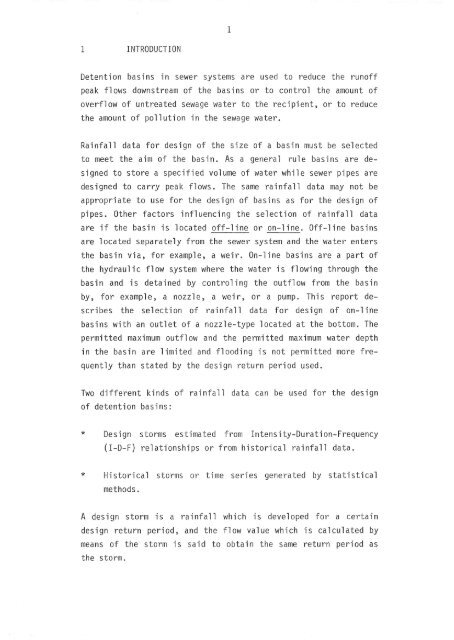Rainfall data for the design of sewer detention basins
Rainfall data for the design of sewer detention basins
Rainfall data for the design of sewer detention basins
You also want an ePaper? Increase the reach of your titles
YUMPU automatically turns print PDFs into web optimized ePapers that Google loves.
1<br />
1 INTRODUCTION<br />
Detention <strong>basins</strong> in <strong>sewer</strong> systems are used to reduce <strong>the</strong> run<strong>of</strong>f<br />
peak flows downstream <strong>of</strong> <strong>the</strong> <strong>basins</strong> or to control <strong>the</strong> amount <strong>of</strong><br />
overflow <strong>of</strong> untreated sewage water to <strong>the</strong> recipient, or to reduce<br />
<strong>the</strong> amount <strong>of</strong> pollution in <strong>the</strong> sewage water<br />
<strong>Rainfall</strong> <strong>data</strong> <strong>for</strong> <strong>design</strong> <strong>of</strong> <strong>the</strong> size <strong>of</strong> a basin must be selected<br />
to meet <strong>the</strong> aim <strong>of</strong> <strong>the</strong> basin. As a genera 1 rule <strong>basins</strong> are <strong>design</strong>ed<br />
to store a specified volume <strong>of</strong> water while <strong>sewer</strong> pipes are<br />
<strong>design</strong>ed to carry peak flows. The same rainfall <strong>data</strong> may not be<br />
appropriate to use <strong>for</strong> <strong>the</strong> <strong>design</strong> <strong>of</strong> <strong>basins</strong> as <strong>for</strong> <strong>the</strong> <strong>design</strong> <strong>of</strong><br />
pipes. O<strong>the</strong>r factors influencing <strong>the</strong> selection <strong>of</strong> rainfall <strong>data</strong><br />
are if <strong>the</strong> basin is located <strong>of</strong>f-line or on- ine. Off-line <strong>basins</strong><br />
are located separately from <strong>the</strong> <strong>sewer</strong> system and <strong>the</strong> water enters<br />
<strong>the</strong> basin via, <strong>for</strong> example, a weir. On-line <strong>basins</strong> are a part <strong>of</strong><br />
<strong>the</strong> hydraulic flow system where <strong>the</strong> water is flowing through <strong>the</strong><br />
basin and is detained by controling <strong>the</strong> outflow from <strong>the</strong> basin<br />
by, <strong>for</strong> example, a nozzle, a weir, or a pump. This report describes<br />
<strong>the</strong> selection <strong>of</strong> rainfall <strong>data</strong> <strong>for</strong> <strong>design</strong> <strong>of</strong> on-1 ine<br />
<strong>basins</strong> with an outlet <strong>of</strong> a nozzle-type located at <strong>the</strong> bottom. The<br />
permitted maximum outflow and <strong>the</strong> permitted maximum water depth<br />
in <strong>the</strong> basin are limited and flooding is not permitted more<br />
quently than stated by <strong>the</strong> <strong>design</strong> return period used.<br />
Two different kinds <strong>of</strong> rainfall <strong>data</strong> can be used <strong>for</strong> <strong>the</strong> <strong>design</strong><br />
<strong>of</strong> <strong>detention</strong> <strong>basins</strong>:<br />
*<br />
*<br />
Design storms estimated from Intensity-Duration Frequency<br />
(I-D-F) relationships or from historical rainfall <strong>data</strong>.<br />
Historical storms or time series generated by statistical<br />
methods.<br />
A <strong>design</strong> storm is a rainfall which is developed <strong>for</strong> a certain<br />
<strong>design</strong> return period, and <strong>the</strong> flow value which is calculated by<br />
means <strong>of</strong> <strong>the</strong> storm is said to obtain <strong>the</strong> same return period as<br />
<strong>the</strong> storm.















